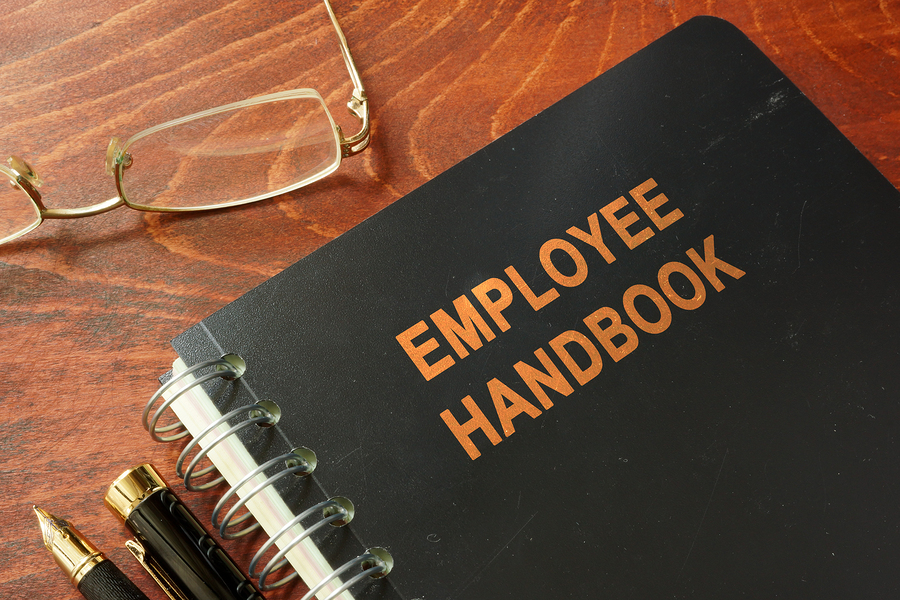Do we have an employee handbook? When was the last time someone reviewed or updated it? Is it even that important to have an employee handbook? Do we really need THAT in the handbook?
As an employer, if you have asked these questions or any other regarding handbooks, you are not alone.
Why should an employer have an employee handbook?
Employee handbooks are not required by law, but it is a best practice to have one. There is information that employers are legally required to communicate with their employees regarding employee rights. An employee handbook should also be treated as a tool and a valuable resource. Think of it as a guide or user manual regarding employment at your company that is used by employees and managers on what is expected of each. This might include an attendance policy, standards of conduct, and various other policies.
As companies grow and change over time, so should their employee handbook. It should be treated as a living document to be reviewed and updated as required. The company may have employees working in other states whose laws differ from those where the company is located, and the different legal requirements of those jurisdictions will need to be included. Reasons to update might include a new company Paid Time Off (PTO) Policy or if a new employment law has been passed.
Now that you understand the importance of having a compliant employee handbook, you may be wondering how to get one if you don’t have an HR person on staff. The good news for small- to medium-sized businesses is that a Professional Employer Organization (PEO) such as Resourcing Edge can help! Resourcing Edge has a dedicated team of experienced HR professionals who can provide your company with a legally compliant handbook and oversee its revisions.
What should be included in an employee handbook?
- User-friendly language and a reasonable length.
- Policies regarding applicable federal, state, or local employment laws. These might include:
- At-will employment, all states but Montana
- Equal Employment Opportunity (EEO)
- Anti-Discrimination, -Harassment, and -Retaliation
- Accommodations (disability, religious, etc.)
- Leaves required by law, paid and unpaid (Family and Medical Leave, sick leave, military, voting, jury, etc.)
- Operational policies. These might include:
- Employment classifications
- Compensation administration
- Working hours and schedule
- Breaks and meals
- Overtime
- Benefits. These might include:
- Benefits overview
- Holiday and PTO, including bereavement
- Safety and workers’ compensation
- General standards that are applicable to the employer. This is not meant to be an all-inclusive list.
- Workplace Conduct and Discipline – do not make this too restrictive
- Attendance
- Social Media and electronic communications
- Conflict of interest and business ethics
- Employee dress
- Smoking
- Right to search
- General disclaimer that notifies employees and managers that this handbook supersedes all prior handbooks and that the policies are subject to change with or without notice.
- Employee review and acknowledgment. When onboarding a new employee or creating/revising an employee handbook, it is essential to distribute it to employees for review and acknowledgment. Otherwise, how will employees be aware of the expectations?
What should not be included in an employee handbook?
- Legalese. Do not include employment, arbitration, non-solicitation, non-competition, or non-disclosure agreements. These are legal documents that need to be created by an employment law attorney and should be presented to employees separately.
- Company procedures, work processes, and job descriptions should not be included so that you will not need to update the entire handbook each time one of these changes. It is a best practice to outline these in your separate operations manual.
- Health and welfare benefits details. These should be included in a separate benefits guide to be updated annually.
- Policies that may infringe upon the National Labor Relations Act (NLRA). The NLRA protects an employee’s rights to engage in protected, concerted activities to address or improve working conditions; or refrain from engaging in these activities. Some examples of prohibited policies include: forbidding employees from discussing wages and other employment issues or an overly restrictive social media policy.
Creating an employee handbook can be a daunting and intimidating task. You don’t need to do this on your own. With Resourcing Edge, companies can depend on our HR expertise in creating a clearly-written, legally compliant employee handbook that meets your business needs.
Jackie Clausnitzer, HR Services Partner at Resourcing Edge, has more than 25 years of HR experience gained at manufacturing and service companies. She is certified as a Professional in Human Resources (PHR) and a SHRM Certified Professional (SHRM-CP).
- What’s in a Name? The Difference Between Layoff, Furlough, and Reduction-in-Force - May 1, 2020
- Intro to Fair Labor Standards Act (FLSA) Protections & Coverage - March 13, 2020
- The Do’s and Don’ts of Employee Handbooks - January 18, 2020

